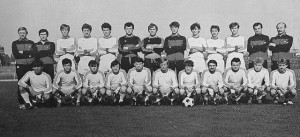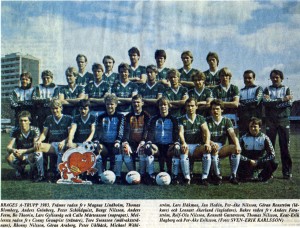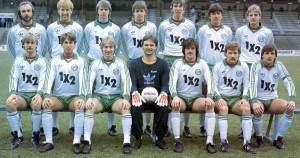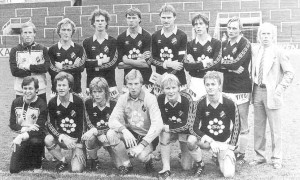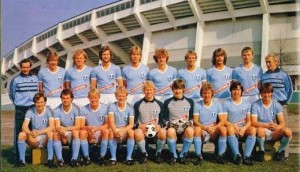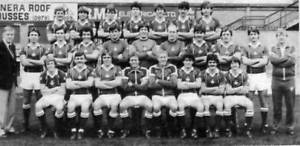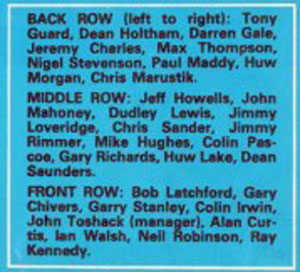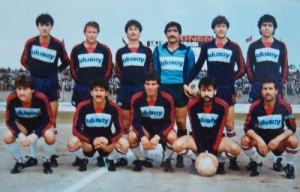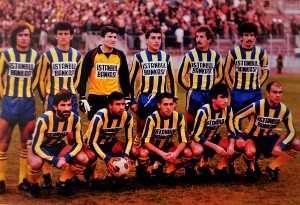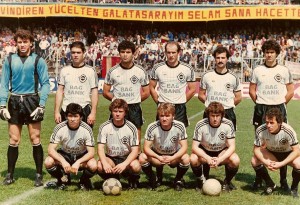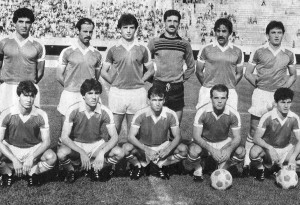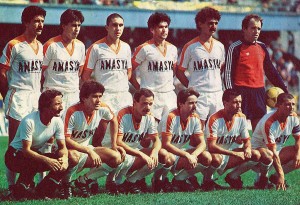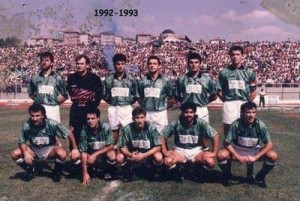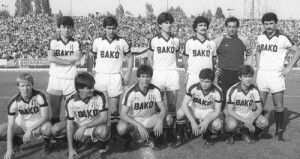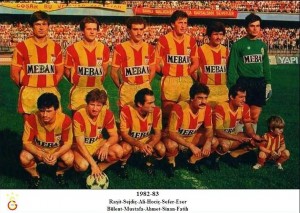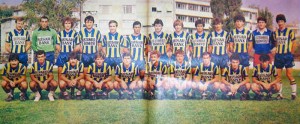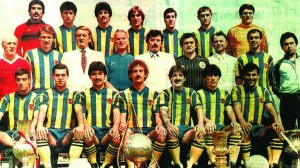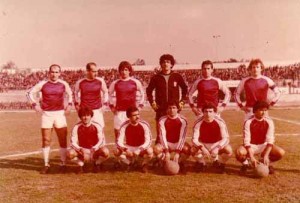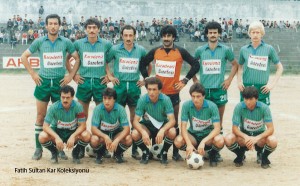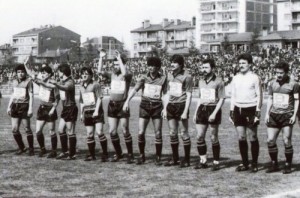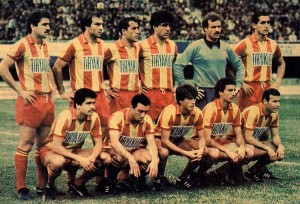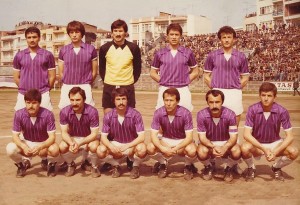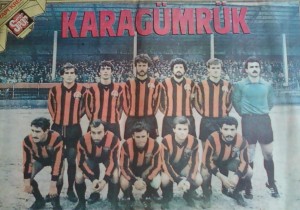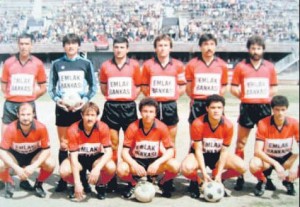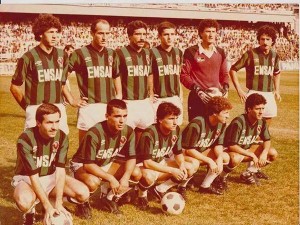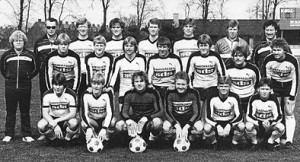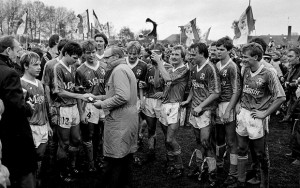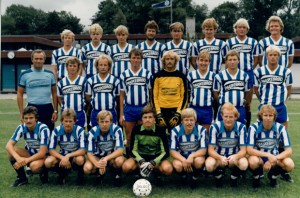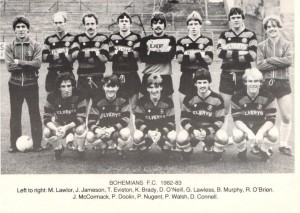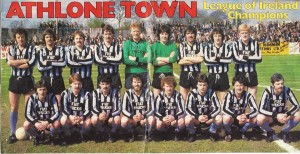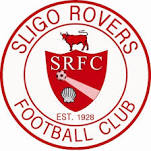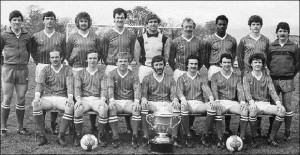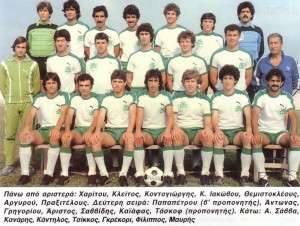First Division. Fairly equal championship, as it always was. Two teams eventually built a gap between themselves and the rest, but the rivals for the title did not really dominate the championship. However, their was already noticed change – the favourites were not traditionally strong clubs and in the same time there was sharp decline of some former leading clubs.
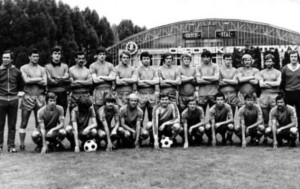 The most noticeable decline was that of Stal (Mielec), one of the best Polish clubs in the 1970s. But the stars, who made Polish football famous, were long gone to play abroad and without new talent of similar quality the club slipped down. They finished next to last this season and were relegated.
The most noticeable decline was that of Stal (Mielec), one of the best Polish clubs in the 1970s. But the stars, who made Polish football famous, were long gone to play abroad and without new talent of similar quality the club slipped down. They finished next to last this season and were relegated.
Gwardia (Warszawa) ended 16th, but their relegation was not surprising – Gwardia belonged to a distant past already. Their strong years ended with the end of the 60s and by now they were expected to play in the second division, not in the first.
The other club in sharp decline was Gornik (Zabrze) – they finished 12th with 28 points. Well, they had to worry – the sorry example of Stal was more than warning. By now, Gornik was reduced to the caliber of modest Zaglebie (Sosnowiec).
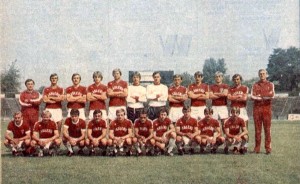 Which bested Gornik by a point and finished 11th. For Zaglebie this was almost great – just keeping a place in the top league meant successful season.
Which bested Gornik by a point and finished 11th. For Zaglebie this was almost great – just keeping a place in the top league meant successful season.
Legia (Warszawa), 8th, and Wisla (Krakow), 5th, were more or less in decline as well – still in the upper half of the league, but not a factor.
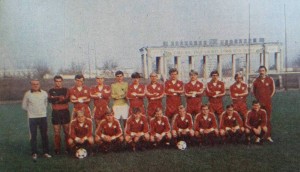 Wisla (Krakow) – nothing memorable this season, but at least preserving its traditional place in the upper half of the league. Perhaps the most steady and consistent Polish club, although rarely a title contender.
Wisla (Krakow) – nothing memorable this season, but at least preserving its traditional place in the upper half of the league. Perhaps the most steady and consistent Polish club, although rarely a title contender.
 And to a point, Slask (Wroclaw) was down – they finished 6th, but for a team expected to play strong role in Polish football since 1975 to finish with 30 points from 30 games was more of a sign of general weakness than an occasional underperformance: looked like Slask was unable to keep strong team in long term.
And to a point, Slask (Wroclaw) was down – they finished 6th, but for a team expected to play strong role in Polish football since 1975 to finish with 30 points from 30 games was more of a sign of general weakness than an occasional underperformance: looked like Slask was unable to keep strong team in long term.
Of all clubs leading in the 1970s and putting Polish football on high world scale, only Ruch (Chorzow) preserved its leading position.
 Ruch finished 3rd with 35 points. Granted, the team was not as strong as the squads of the 1970s, but unlike the other leaders of the previous decade it was not declining. At least not much declining – a good squad, but not able to keep up with more inspired teams and eventually slipping out of the race for the title. True, they ended only 3 points behind the 2nd placed this season, but it is also true that 35 points from 30 games is not much. Ruch did not lose many games – only 6 – but winning was also not up to them: they tied 13 matches and only lowly Cracovia (Krakow) tied more – 15. But Cracovia was merely fighting for survival and succeeded, finishing 14th – Ruch was supposed to win the championship…
Ruch finished 3rd with 35 points. Granted, the team was not as strong as the squads of the 1970s, but unlike the other leaders of the previous decade it was not declining. At least not much declining – a good squad, but not able to keep up with more inspired teams and eventually slipping out of the race for the title. True, they ended only 3 points behind the 2nd placed this season, but it is also true that 35 points from 30 games is not much. Ruch did not lose many games – only 6 – but winning was also not up to them: they tied 13 matches and only lowly Cracovia (Krakow) tied more – 15. But Cracovia was merely fighting for survival and succeeded, finishing 14th – Ruch was supposed to win the championship…
Which left the two strongest.
 Widzew (Lodz) was unable to defend its title of the previous year – they were short of a single point. Battling for the top place, they scored the most goals this championship – 50 – and lost only 5 games, but unfortunately tied too many – 12 – which at the end left them at second place. Since their greatest star, Zbigniew Boniek, left them to join Juventus, a drop was expected, but surprisingly Widzew not only remained strong, but arguably had their finest season, reaching the semi-finals of the European Champions Cup. Perhaps international success was the reason they lost the Polish title – objectively, the squad was not that great to handle successfully two challenging competitions. Yet, by Polish standards it was the best team at the moment, lead by Smolarek, Mlynarczyk, and Wojcicki. Wladyslaw Zmuda more than knew his job – he was already experienced winning coach. May be the best squad, but also typically Polish – the team depended largely on its stars. If Smolarek was the second greatest Polish player at the moment after his former teammate Boniek, Wojcicki and Mlynarczyk were not at the same high level. Mlynarczyk was a point in case: he may have been the best goalkeeper at the moment, but he also was surrounded by controversies and was in the center of a scandal, starting with rather typical dismissal from the national team for drinking, but quickly evolving into political bitter fight. Between the goalposts, he was hardly world-class, yet, he got bronze from 1982 World Cup and later became European club champion. Compared to, say, Zygmunt Kalinowski, Mlynarczyk was a giant: after becoming (without playing even a minute) World Cup bronze medalist in 1974, Kalinowski not only was hardly ever called to the national team again, but was playing second division football by 1982-83.
Widzew (Lodz) was unable to defend its title of the previous year – they were short of a single point. Battling for the top place, they scored the most goals this championship – 50 – and lost only 5 games, but unfortunately tied too many – 12 – which at the end left them at second place. Since their greatest star, Zbigniew Boniek, left them to join Juventus, a drop was expected, but surprisingly Widzew not only remained strong, but arguably had their finest season, reaching the semi-finals of the European Champions Cup. Perhaps international success was the reason they lost the Polish title – objectively, the squad was not that great to handle successfully two challenging competitions. Yet, by Polish standards it was the best team at the moment, lead by Smolarek, Mlynarczyk, and Wojcicki. Wladyslaw Zmuda more than knew his job – he was already experienced winning coach. May be the best squad, but also typically Polish – the team depended largely on its stars. If Smolarek was the second greatest Polish player at the moment after his former teammate Boniek, Wojcicki and Mlynarczyk were not at the same high level. Mlynarczyk was a point in case: he may have been the best goalkeeper at the moment, but he also was surrounded by controversies and was in the center of a scandal, starting with rather typical dismissal from the national team for drinking, but quickly evolving into political bitter fight. Between the goalposts, he was hardly world-class, yet, he got bronze from 1982 World Cup and later became European club champion. Compared to, say, Zygmunt Kalinowski, Mlynarczyk was a giant: after becoming (without playing even a minute) World Cup bronze medalist in 1974, Kalinowski not only was hardly ever called to the national team again, but was playing second division football by 1982-83.
Widzew lost the race for the title to unlikely opponent – Lech (Poznan).
Winning made them champions – Widzew won 13 matches, Lech – 17, including a 3-1 home win against their rivals. At the end, Lech had 1 point more than Widzew and triumphed for the first time in their history.
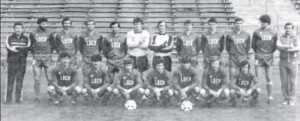 New champions, standing from left: coach Wojciech Łazarek, Józef Adamiec, Józef Szewczyk, Krzysztof Pawlak, Janusz Kupcewicz, Zbigniew Pleśnierowicz, Piotr Mowlik, Bogusław Oblewski, Andrzej Strugarek, Janusz Małek, Damian Łukasik, assistant coach Włodzimierz Jakubowski.
New champions, standing from left: coach Wojciech Łazarek, Józef Adamiec, Józef Szewczyk, Krzysztof Pawlak, Janusz Kupcewicz, Zbigniew Pleśnierowicz, Piotr Mowlik, Bogusław Oblewski, Andrzej Strugarek, Janusz Małek, Damian Łukasik, assistant coach Włodzimierz Jakubowski.
First row: Mariusz Niewiadomski, Jacek Bąk I, Grzegorz Łazarek, Mirosław Okoński, Leszek Partyński, Jerzy Krzyżanowski, Hieronim Barczak.
At a glance, the champions were nothing much… Kupcewicz, Mowlik, and Okonski were the stars, but stars more of the yesteryear. Piotr Mowlik, for instance, not only was out of the national team already, but played fewer matches than his backup, Zbigniew Plesnierowicz. But that was Polish football – a sturdy squad with 3-4 stars was quite enough to get the title – after all, Szombierki (Bytom) won the title without a single classy player. Lech may have been lucky, but champions they were. ‘Kolejorz’ (the Railwayman) was founded in 1922 and from 1933 to 1994 was closely linked to the Polish State Railways, hence, the nickname. A solid club, but never a winner, so this season should have been truly historic. True, the time was hardly perfect for big celebration and football was perhaps not in the mind even of the fans, but strangely this team is hardly mentioned even in the club’s history. Of course, Lech was much more successful years later, after the fall of Communism, but the first champions are not worthy even for a photo today.
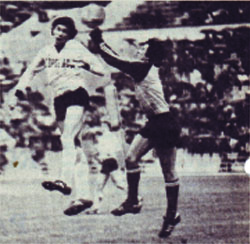
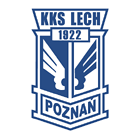
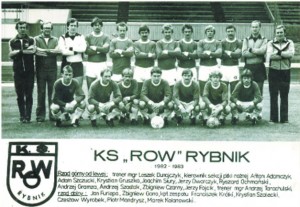
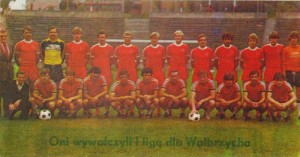
![historia5[1]](/wp-content/uploads/2018/02/historia51-300x144.jpg)
